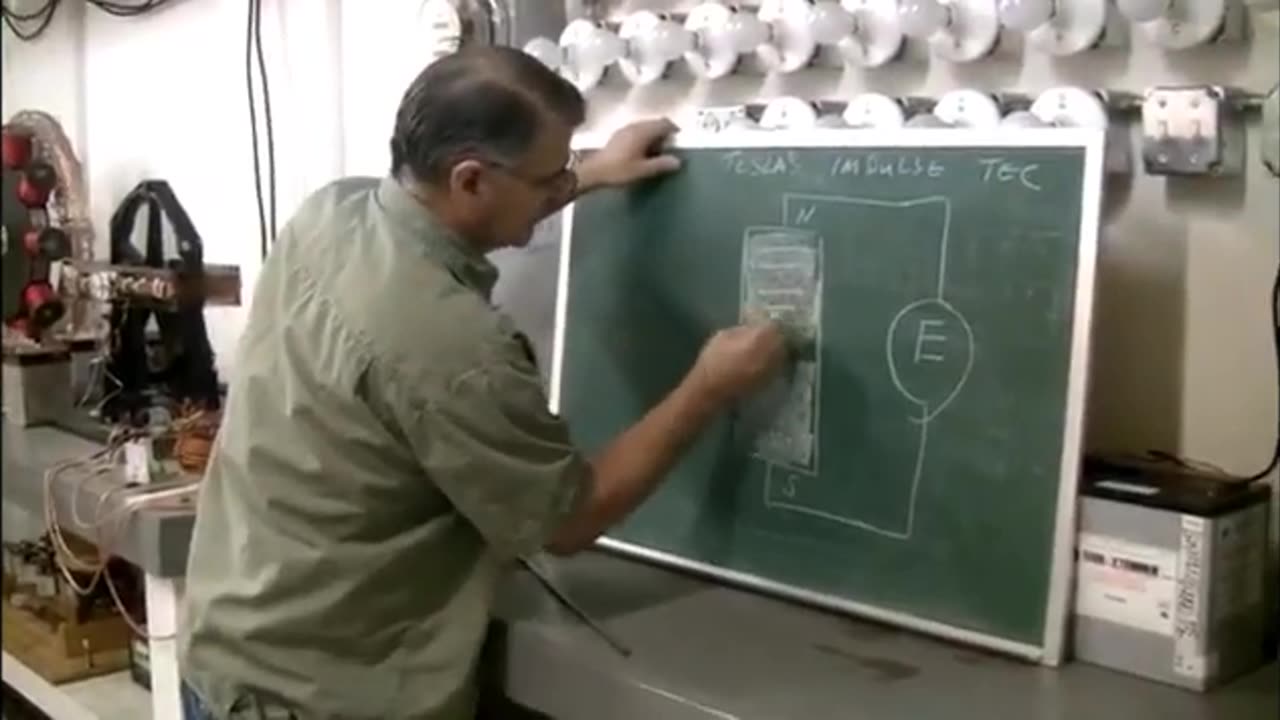Premium Only Content

Energy from the Vacuum - Tesla's Impulse Technology - Zero-Point Energy - John Bedini
Original video here: https://www.youtube.com/watch?v=SrflrgFOU5I
This is a cut down version of the 7th DVD in the Energy from the Vacuum series. In it John Bedini explains what Tesla's one wire Impulse Technology is all about. He uses one of the coils on his SSG motor generator to demonstrate the high potential charging of a battery.
Please keep in mind this is uploaded for Historic and documentary purposes.
SUMMARY
(00:10) Introduction of the monopole motor and its circuitry conversion to Tesla's impulse technology, highlighting the connection of a lead to a transistor and a rectifier to capture spikes of energy from the motor.
(01:20) Explanation of capturing negative electricity to recharge a battery, emphasizing that this process has no effect on the motor's operation and the potential to tap into multiple energy sources within the system.
(03:12) Discussion of a diagram illustrating the monopole motor's circuit, which has one motor drive coil and one trigger coil, indicating the focus on capturing negative energy from the circuit.
(08:39) Description of creating a node on a wire to extract energy using Tesla's analogy and impulse technology, emphasizing the unique nature of the energy retrieved, characterized as high voltage and negative.
(23:49) Overview of the process of capturing and utilizing energy from the monopole motor to charge batteries, mentioning the potential for moving ions in a battery without adding significant current.
(36:15) Observation that the battery is being charged negatively, allowing it to maintain energy despite discharges, indicating a difference in charging effectiveness and longevity between positive and negative energy methods.
(40:12) Final notes on battery depletion and recovery, showing the effects of drawing energy from a battery using impulse technology and noting the importance of not overworking the battery during this process.
Theory:
The energy stored inside of a magnetic field is equal to "E = 1/2 * L * i^2" the coil doesn't care how long it was powered for, the amount of energy is determined by the inductance and the square of the current at the time the power supply is cut.
Using an impulse driver causes the flyback efficiency to be nearly 100% and at the same time, it's still making a magnetic field and that field still accelerates the rotor according to time it existed for and it's average strength. The fact that the rotor accelerates does not change the fact that the energy in the coil is still "E = 1/2 * L *i^2".
The "overunity" comes from that the energy that powered the rotor motion is almost completely refunded by the flyback energy recovery system and now you have a rotor with inertia.
TRANSCRIPT:
(00:10) ♪♪ ♪♪ ♪♪ ♪♪ ♪♪ ♪♪ Okay, this is the monopole motor, and what we're going to do is convert the circuitry from the monopole circuitry to Tesla's impulse technology. Now, you'll notice right here that we just connected one lead to one of these transistors, so we're actually across this coil,
(01:20) this direction, with the rectifier right here. So we'll start this thing, and what we'll show you is these spikes of energy right here on the scope. And actually, you can see the spikes here. So what we want to do is we want to steal this impulse that you see on the scope here. We want to actually capture it and send it to a battery to recharge the battery. So when we do that, if we watch the battery, we'll see then the impulse technology is still there.
(02:02) So we'll expand this a little bit so you can see what we're capturing. But see, it goes below the line now. It goes into the negative region of the coil, just below the line. Okay. So what we're actually doing now is we're taking the negative electricity and telling it to charge this battery. And we can see that there's no effect on the motor. And there's actually two or three different places that we can tap this negative energy.
(02:39) We could, for instance, insert another coil in series with this and capture another high voltage across this coil. And if we walk over here to the blackboard, we'll sort of explain it to you. Here's the circuit of the monopole motor. And you can see that there's one motor drive coil. There's one trigger coil because we need the trigger to set the impulse technology into operation. But the one thing that's different, you'll notice here,
(03:12) is now the rectifiers are placed across just one coil. So if we take this coil and we just give it an impulse and shut it off, what we're going to do is capture the negative energy in the system. And so this is exactly what's happening here. We just want to capture the DC impulse technology and send it to the next battery. Now Tesla's analogy was this straight wire down here with a light bulb across the wire.
(03:49) Now with the impulses, I'll just draw it this way. When the impulses are correct, a node appears across this wire. A node. N-O-D-E. N-O-D-E. Nodes. And that's where the voltage is. Then the free energy appears, and that's right here. Because no longer are you adding any energy or subtracting any energy from the system. The vacuum puts this in. And you're free to take this energy across this node. Right here.
(04:39) So here's the node. Here's the monopole motor. It's connected up with just one coil. So no matter how many coils you put in this system here, you're just going to collect the energy across the one node. These are meaningless then. So we don't ever need to put them in there. Now, if we want to get some more energy, we could just put another coil here, connect it to a rectifier, and say charge a capacitor. And then we could change this from negative to positive energy,
(05:36) and then discharge. Let's do that. Once again, we're asking the motor to generate them. We're asking to charge that battery. Now we've changed the total output of the negative energy. You can see it here. Okay, now what did you do here again? We just added a coil like we drew on the board there. Now we're going to rectify that coil and charge a condenser with that coil. A smaller condenser because we're at a higher frequency here.
(06:48) So actually what we're looking for is, we're looking for all the possible negative energy in the total system. We want to be able to capture all this energy without adding any more input to the circuit at all. Now this is actually taking the energy from this node across this coil. The node's going to appear here across these two points in the total system. Because see, the system is a series system. The node is going to appear across this inductor that we just put in here.
(07:53) So if we erase the total circuit, here's where the energy is going to appear. Remember that we want to work with Tesla's analogy of the one-wire system. Because we're just going to use this one wire to capture the energy. So what I've done is since the motor is oscillating with this impulse. Now this is not AC and it's not DC. It's just an impulse coming from the motor. So you could call it a form of DC impulse at a certain frequency rate,
(08:39) which the motor is putting out a certain frequency here. So what we want to do is create a node on this wire. And then right at the tip of this node, we want to take the energy off this wire. Because then we don't have to put any more energy in the wire. It's already there. So here's basically what our circuit's going to look like. And we're just going to take the energy from this node, rectify it, bring it to a capacitor.
(09:25) We're going to take the energy from this node, rectify it, and bring it to a battery. On this end. So we have a plus and we have a minus coming off this node. And we have a plus and a minus coming off this node. And we're not going to put any more energy into the system to get the energy out. So. to measure that here. What's coming across this node is about minus C. Let's just reverse it so we can get a positive reading.
(10:20) There's already 86 volts across this node, which you could dump to another battery in an impulse discharge. Meanwhile, this battery is receiving energy negative-wise, and is now up to 13.4. So let's drain this energy off and watch it charge. What happens when we drain this energy off of this battery? And then we'll watch this node. So just to be clear, this is the node? We're taking this straight wire, this inductor. Right.
(10:59) This is a series configuration, so it's exactly as it's drawn on the board there. Okay. And we're taking energy from two points in this circuit, which is negative. Right. One in series with the other coil. Right. So a node appears across this one, and a node appears across this one, only when the impulse technology is in place. And what I mean by that is the DC has to be in impulses, like this. If there's no impulses, there's no energy. Right.
(11:43) Okay? This is exactly what Tesla's talking about when he talks about impulse technology. It's been mentioned in a couple of different books. Jerry Vassilatos has mentioned it. Tesla mentions it. Tesla calls it something, he calls it radiant. But you can see, it is radiant and negative at the same time. And what we want to be able to do is create an impulse on this wire, which means the circuit's never steady on. And then what we want to be able to do is the wire will supply the energy at the correct frequency
(12:29) in a node. And that's what you want to take to charge your battery or charge up a capacitor here. You want to be able to not only charge the battery while you're running the motor, you want to be able to charge another capacitor bank so that you can dump that to another battery if you need it. And by the way, this is real positive energy when it comes off here, and negative when it comes off here.
(12:53) So no matter how many nodes, you can keep at the right rate, you can keep adding these circuits like Tesla did. So this is the term where Tesla takes the circuit and he shuttles the energy around the circuit. Because each one of these is going to give him an energy. Each one of these. So if he takes the energy here that he's losing in this circuit, and then he shuttles it back over here to some other part of the circuit, now he's got this energy that's feeding the circuit for basically
(13:37) nothing. Zero cost. He's only putting in one trigger signal that's always staying the same, but yet the one wire is supplying all this energy to this different component. And that's the term shuttling energy back and forth around the circuit. Like if I took a little bit of this, disconnected this, discharged this, then the motor still runs, and all I've done was charge this capacitor and put it over to the motor. So I can flip this energy around the circuit.
(14:13) Now we can charge a bigger capacitor and then run the motor on that capacitor, disconnect it, shuttle some more of that energy around the circuit. So this is impulse technology. So what are we doing? What are we actually doing? We have this coil, and when we energize this coil, let's say we put energy into this coil, we'll just call it E, which is potential. We're going to put energy into this coil, and this coil is going to do this.
(14:51) It's going to charge, and it's going to move this magnetic field down just like this. Where this is the North Pole and this is the South Pole. It's going to compress it. Okay, so now we actually look at this coil. We've compressed this. We're in impulses, so we're compressing this real fast. It's moving down in layers. How do you know it's moving down in layers? Because of the energy output of the coil.
(15:34) Okay. Okay, we know that we're putting it in, it's just dead solid. It's like a permanent magnet, but this is an electromagnet. So with an electromagnet, we can turn the energy off and on, gating negative energy or vacuum energy. This one is stationary. Once charged, this neutral zone, or what they call the blotch wall, is actually the input of all the energy. It's B-L-O-C-H? Yes.
(16:00) So let's get this in an expanded view so you can see this. Then we'll go back to the coil and show you how this energy is going to become an energy pump. With a stationary magnet, once you charge this magnet, the North Pole stays here and the South Pole stays here. But what people don't understand is this is the zero portion of the magnet. There's nothing there. It's the absence of all gravity and everything. So that means the gravitational energy of the magnet is off over here somewhere.
(16:43) All right? So what's happening is once we charge this magnet, the particles align, the oscillation stays, and what we get is two cones. And the energy enters in this way on each side. That's the vacuum energy. So in a permanent magnet, you have a real free energy machine because this is good for your life. It stays stationary, but it doesn't bias anything because we don't have a mechanism right at this point in time to tap this input from both directions.
(17:30) This is the energy of the universe entering this magnet because it stays permanent. It stays in a perpetual state of magnetism. So it is a free energy machine that's sticking to your refrigerator. Now, let's go back to the coil. What we want to do is create an energy pump to draw the vacuum in. So we apply an impulse technology, which are these high voltage potentials, to the coil. The coil pulls in.
(18:16) When we shut this off, this portion that's been compressed, which is now at this level. We're going to leave this out here so you can see this. It's at this level when it's compressed. Now we let the energy loose, and this window starts to move this cone upward for more input energy, and that's where the high voltage comes from. Let's redraw this a little bit so you can get a better idea of how this is going to work. This is our coil symbol. This is an electromagnet because we have some iron here.
(19:11) So when we put the potential across this, this becomes a north pole and this becomes a south pole. And you look at it as a normal electromagnet. However, what we want to create is a vacuum energy pump. So we have to add the impulses. And we look at the coil like this, and we have these different levels. So here's what's going to happen. We charge the coil, and we get a blotch wall. So we can look at the energy coming in, in a narrow beam right now.
(20:00) We have to release, we have to be able to release this so that we can ask the vacuum to pour in energy because right now it's just stationary as if it was a permanent magnet. So when the transistor lets loose in the monopole motor, it moves upward, the coil starts to collapse. When the coil starts to collapse, notice the vacuum window starts to increase. It's up here, the vacuum window increases to here, increases to here, increases to here until it goes to zero.
(20:47) Then we add the next impulse and this comes back down, compresses again. So it compresses and expands, compresses, expands, compresses, expands. And each time you do this, what happens is the output from this coil is the thing that burns out your circuit, which is this very high potential that wasn't there in the beginning. This is the vacuum energy. The normal signal is an impulse trigger. That's how the normal signal would look. It's like a little square wave.
(21:31) This would be zero volts, this would be 12 volts. So the real back EMF is always going to be far less because of the resistance of the coil. So it's going to want to shoot like this. Shoot downward because it reverses, right? But when you add the impulse technology to it, what happens is you get this tremendous vacuum energy spike that appears on this. And these are 300 to 500 volt ranges. Okay, and it's always negative.
(22:18) It's charging the battery in an inverted circuit on this machine. So what we want to steal is this right here, and I call it stealing. This is your free energy right here, also the mechanical energy. So here you are running your motor for this amount of energy, never adding any more energy to the system. The back EMF, everybody likes to term this back EMF because they say, well, the coil reverses, that's the back EMF.
(22:57) That's very untrue. The back EMF is always below the input voltage. So the back EMF here may just be 8 volts. That's not enough to charge your storage battery or to do anything with. So there's always a loss here. This is your loss range. So you try to increase this to get more, and the current just starts to rise. The minute the current catches up in the system, you lose all your vacuum input. So you have ranges that you can bring the current to on the monopole until you just can't get anything out of it.
(23:49) So basically that's what I wanted to explain about the monopole motor, that it's quite capable of doing Tesla's impulse technology. And I can show you a real back EMF return on one of these window motors in a little bit, and you can see that you can't charge the battery with it. You don't get anything. So you need this high potential way beyond the battery voltage. And you take this potential, and you convert it, and you send it to the next battery.
(24:26) And it's just a signal to the next battery. If you look at the two plates in the battery, and we'll just call these big basketball ions, what we want to do is potentialize these ions. So we want to put a potential around this ion, because we want the ion to move to the next plate for nothing. We don't want to add any current. We want this stuff, we want these ions to all go towards this plate in a recharged fashion.
(25:15) That way it hasn't cost us very much to move these ions. We didn't have to use a big current to move them to the next plate. Now is there any energy in the battery after using the impulse technology? So is there any real energy in this battery now from charging it with this impulse technology? And how quickly does the impulse technology charge this battery? So let's find out. So we'll stop the machine, so we can bring these lights around here.
(25:57) Okay, so now we're going to see what the impulse technology actually put in the battery. And we'll run it down a little bit here, and then we'll ask the impulse technology to charge it back up. We're pulling it out at a 30 amp rate off a garden battery, which is a 13 amp hour battery. So the battery's technically dead right at this very moment, our garden battery. But we could pull it all the way down to 10 volts.
(26:35) What do you mean by garden battery? It's a garden battery that you'd find in your lawn tractor. Okay. Okay, it's just a cheap little $24 battery that you'd use for lawn equipment to start your lawn mower. So notice it's holding right here. So it's found a level to where it could supply the current for a certain period of time. And the battery will move down a level. So it's just starting to move down now.
(27:13) Of course, we're asking this battery to do a lot of work on a C1 scale or below. You know, this battery just can't do it. So now, let's see where it recovers to, and then let's add the impulse technology to it. Remember, the ions are still moving in this battery because of the way that we were charging it. So not only are they trying to reverse, they're trying to go back the other direction right now, like if you stretched out a spring.
(28:08) See, because that battery is already at a standing voltage. So this is like the rebound effect that you talk about in your book. Yes. Yeah. So now, we've hooked up the machine. And we're going to ask it to charge it. So right again, there we can see it go beyond to the negative. See, notice the wave shape doesn't look the same as the normal motor wave shape because we've told the machine not to capture it from one specific end.
(29:06) Now, let's see where this battery goes. Now, if we take this one off, where do we tell it? Just apply that impulse only to this device, and then you notice that it's starting to climb right up there. But we only need one coil to do this, see? We only need one wire to capture this from. The others are meaningless at this moment. So where's the capturing taking place? Just on one of these wires, just across.
(30:00) one of these wires. You can see it's here hooked across the coil as I and I'll draw it on the board one more time where we hooked it up. So what we did was we have our transistor and we're just going to call this the ground. We've got one coil that's being triggered from this north pole. So this is our trigger signal that's going to generate this wave. We're going to clamp that wave so we don't want to burn the transistor on.
(31:03) And then if we just took this coil that was the motor and we have our input battery. We're going to generate these impulses across this coil. Then we're going to tap across this coil and we're going to take the negative energy that enters this coil. And of course the scope is going to show it. We want this portion, we want the negative energy. We're going to take this output and charge our battery. What we want to use this for now is an energy pump.
(32:00) We want to pump this back and forth with this impulse. And then when the node develops across this coil, we want to take that node, take that energy and put it to the second battery. That's what we're doing right here, right now, because we're up to 1287, 8800. And it'll continue to climb. 16, 17 volts. So we're also looking at these spikes. We've magnified these spikes because the
(33:07) minute we disconnect this, Tony, the voltage is going to shoot off the scale. And we'll do that real quick here. Now we have to lower it down quite a bit. See, it's below the line. There's nowhere for that energy to go. So the minute we tell the vacuum to catch it, right, we want to catch it in this energy pump, then what you see is this. See? It's below. Yeah, that's the negative energy.
(33:41) Yeah, we want the negative energy portion of the wave. So the motor is just going to do its normal thing. It's going to continue to do its work while it charges its second battery. But it's just going to charge it a little bit differently. It's going to charge it in a negative time. Batteries like to be charged in a positive time. So we're almost up to 13 volts now again, which isn't really long to wait, considering you kept the same input power no matter what, and you're doing work.
(34:29) Yeah, absolutely. I mean, it takes a lot to move this fan. Anyway, we're right in the middle of this impulse technology charging, and we can see that the battery now is up to 13.30. I think that's enough. This is after how long have we been waiting? We've been waiting about an hour for this. And so what we're going to do is shut the machine off and watch where the battery comes down to.
(34:59) And you can see this is a totally different charge because the battery is not dropping. It's on a time charge, a negative time charge. So now all we want to do is we want to take the energy out of the battery. So we're going to do that again. I'm going to load the battery. You're going to turn the lights on? Yes. Okay. And so there we go. And then we're going to watch the meter here on this time charge. Okay. Okay. So 12.07. Yeah, 12.07.
(35:27) And so remember last time that within a couple of minutes it was down to 11. Right. 12.12 right now. Yeah. So now it's going to, you can see that the energy is in the battery. But this is a totally different kind of energy because it's been charged negatively. And so the lights are a lot brighter than what they... Okay, so because it's negative energy, it's going to deplete that much slower? Yeah, it's a little bit slower than the positive charge.
(36:15) Like what percentage? How much? Well, maybe 5, 10 percent. But the point is, it charged the battery negative-wise on Tesla's impulse technology, which nobody's ever converted his impulse technology to charging batteries. And that was the main function of this experiment was to charge the battery with negative energy. We're just going to let it go here. See, and it's going to find a spot. It's just going to stay there because remember it's still charging.
(36:49) It's still charging? Yeah, it's still trying to charge itself from the ion movement. Oh, the momentum. Right. So how long will that... See, it's got a little bit higher plateau this time. Yeah. So how long will that... A little bit longer, maybe about 5 or 10 minutes longer. So the ions are still trying to move. They're still moving because if we disconnect the load... See, it's already past standing voltage. Right, you're back to 12, 13. Right. Remember, this is a 30 amp load. Right.
(37:28) So we're... And this is a 13 amp hour battery, so we're asking it to do a lot. And actually, let's just ask it to do 60 amps. So now we're asking it to do 60 amps worth of work. And you can see it's on a plateau here. Not really moving down that quick. But that's 60 amp load. So that's way beyond this battery's capacity. And we'll take it down to 10.5. So we're going to go on that energy right down to 10.5. And then we're going to tell the machine to charge it.
(38:23) We're going to take 30 amps from it. 11.24, 23. Yeah, it's pulling it down pretty fast. Mm-hmm, 60 amp load for a 13 amp hour battery, which is like unheard of. It's quite a curve there. Right, right. Of course, you won't want to do this too much to the battery. Yeah, you won't. You don't want to really do this to a battery. But just to prove our point that the Impulse technology can charge this up from zero, we're going to take it out.
(39:14) But actually, the negative energy is easier on the battery, isn't it, than the positive energy? Yes. In that there's no current involved in it. Yeah. Okay, so as soon as we get to 10.83. Mm-hmm. I'd say that's a pretty good size load for a start battery and a garden battery at that, at 13 amp hour. You can see there's a lot of energy in these batteries, because if you take one off, that's a 30 amp load. It should bounce. come back up, see? Yeah. So we just go ahead and pull it down.
(40:12) 1040. Yeah, we're just going to take it down to zero. It'll drop all of a sudden. Yeah. So that's way past where you'd want to take a battery. Yeah, it's diving down now. Well, it's diving down, but notice the lights. Yeah. So what happens if you... Now you're starting to see... Yeah, the dimming. Yeah, the dimming. And now it'll just take a quick dive. Yeah, it'll take a quick dive because we're depleting it completely.
(40:56) So what happens if you keep... If we keep doing this, we're just going to destroy the battery. Because the storage battery is what it implies. It stores energy for use. It's not made to do this constantly. So we have to dive it down. But look here. We'll just go back to the 30 amp load. And of course we depleted it. And we'll let it rest for a minute, see where it recovers to. And then we'll take the rest of the energy out of it.
(41:28) So now we can take the rest. So we let it recover a little bit. Yeah. Pull some more out of it. So what I want to do is show you that...
-
 4:23:47
4:23:47
MissesMaam
8 hours ago*Spicy* Friend Friday with Mally_Mouse and Friends!! 💚✨
296K16 -
 2:05:09
2:05:09
TimcastIRL
9 hours agoRIOTS Leftist ATTACK ICE, Tear Gas Deployed, Feds Ordered To IGNORE CA Law, CIVIL WAR! | Timcast IRL
323K237 -
 15:57
15:57
Robbi On The Record
1 day ago $8.59 earnedTranshumanism: Are Humans Becoming Obsolete? Neuralink & CRISPR explained
51.8K20 -
 2:22:21
2:22:21
TheSaltyCracker
10 hours agoICE Smashing Antifa ReeEEStream 9-26-25
121K184 -
 7:47:28
7:47:28
SpartakusLIVE
10 hours ago#1 HERO of the PEOPLE || Ending the Week with FUN, WINS, and LAUGHS
85.7K -
 3:52:22
3:52:22
SynthTrax & DJ Cheezus Livestreams
20 hours agoFriday Night Synthwave 80s 90s Electronica and more DJ MIX Livestream THE FLOATING WORLD / Variety Music Edition
44.1K3 -
 7:43:24
7:43:24
Eternal_Spartan
16 hours ago🟢 Eternal Spartan Plays Destiny 2 | FPS Friday | | USMC Veteran
49.8K4 -
 2:04:11
2:04:11
MattMorseTV
11 hours ago $23.04 earned🔴The UK just hit ROCK BOTTOM.🔴
78K185 -
 5:37:54
5:37:54
iCheapshot
8 hours ago $7.28 earnedBack From Vacation! | Checking Out Skate Maybe Some Boarderlands 4
69.8K1 -
 3:08:37
3:08:37
Jorba4
8 hours ago🔴Live-Jorba4- Borderlands w/ The TRIBE
54.9K